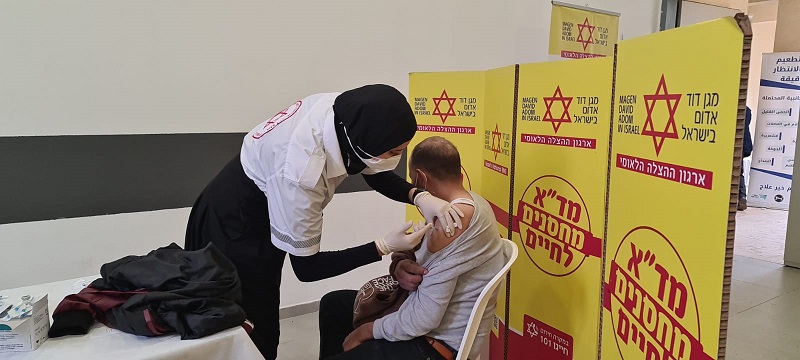
As an increasing number of Israelis become eligible for a 3rd shot, efforts are still needed to get a first dose in the arms of 30% of Arab society.
After months of optimism for a “post-COVID” era, the Delta variant has unleashed another wave of infections and hospitalizations in Israel. As in the first cycles, Arab society in Israel presents unique challenges for prevention measures and higher vulnerability to the economic impact.
As of August 11, Arab communities had lower COVID-19 rates than average: 11% of cases are in Arab localities, low compared to the 21% share of the population. There is also only 1 Arab city out of the 26 cities designated “red” in the traffic light system. However, public health experts are concerned that, like the first period of the pandemic, Arab communities are simply a couple of months behind Jewish ones and that the worst is yet to come.
Recent studies show that in prior waves, mortality rates from COVID-19 were three times hire among Arabs than in the general population. The infection rate in the Arab population was 9% compared to 6.5% in the general population, with 8% of those infected hospitalized compared to 5%. Economically, a new report from Israeli Employment Services found that Arab employment rates dropped 11.7% since April 2020, compared to 8.4 percent among Haredim and 7.2 percent among non-Haredi Jews, and shows that Arab citizens continue to struggle more to return to the workforce.
Vaccination Rates
Of the 1.1 million eligible Israelis that are still unvaccinated, a disproportionate 404,000 are Arab, or 36%. Significant progress has been made in increasing Arab vaccination rates since vaccinations became available, but gaps remain:
- 71% of the 1.4 million eligible Arab citizens have been vaccinated compared to 78% of the general population.
- By region, Negev Bedouin still lag farthest behind, though concerted efforts have brought rates up to 60%–a misleading average because of the wide variance between communities. Segev Shalom and Rahat, for example have vaccination rates of 24% and 36% respectively.
- By age, young people remain a major concern. Only 16% of Arab children ages 12-15 have been vaccinated compared to 34% of Jewish children.
As more Israelis become eligible for a 3rd booster, similar concerns apply. Prof. Bishara Bisharat, chair of the Israel Medical Association’s Society for Health Promotion in the Arab Community and a senior member of the Health Ministry coronavirus taskforce for the Arab sector, says that different Arab communities present their own challenges: “In East Jerusalem, there is a lack of trust in all state systems, so it is difficult to get people vaccinated,” he says. “In the Negev, people have low socioeconomic status, and … there is a lack of health literacy and an adherence to misinformation… There is a similar story in the north, even in large cities like Umm al-Fahm. People are on the street without masks and the clinics are empty of those coming to get vaccines.”
According to Riad Majadle, a Health Ministry adviser on COVID-19 and Arab society, half of COVID-19 hospitalizations among Israelis under 55 are unvaccinated Arabs. He explained, “There are still many people who are either apathetic, or there are those who think this is all about politics, or an economic conspiracy, or some such.” On August 8th, Prime Minister Bennett urged young Arabs, “Go out today to get vaccinated. That way you will not be infected and will not infect. It will save the lives of your loved ones.”
Leadership
In July, Colonel Brigadier Salman Zarka became Israel’s new chief coronavirus czar. Zarka is a Druze epidemiologist who previously Directed Ziv Medical Center in Safed. As Arabic-speaking minority from the periphery, he brings unique sensitivity and awareness of the health needs and challenges of Israel’s minority groups. Dr. Zarka reappointed Aiman Saif to head the Ministry of Health’s COVID-19 response in Arab society. Working to close imminent gaps and promote the health and safety of the population, Saif is also looking at the long run: “The Arab community arrived at the coronavirus crisis in a poor health and economic state and the crisis only sharpened the gaps between Arab and Jewish society. But on the other hand, the crisis could be an opportunity to deal with fundamental problems for the Arab community.”
Further Reading
